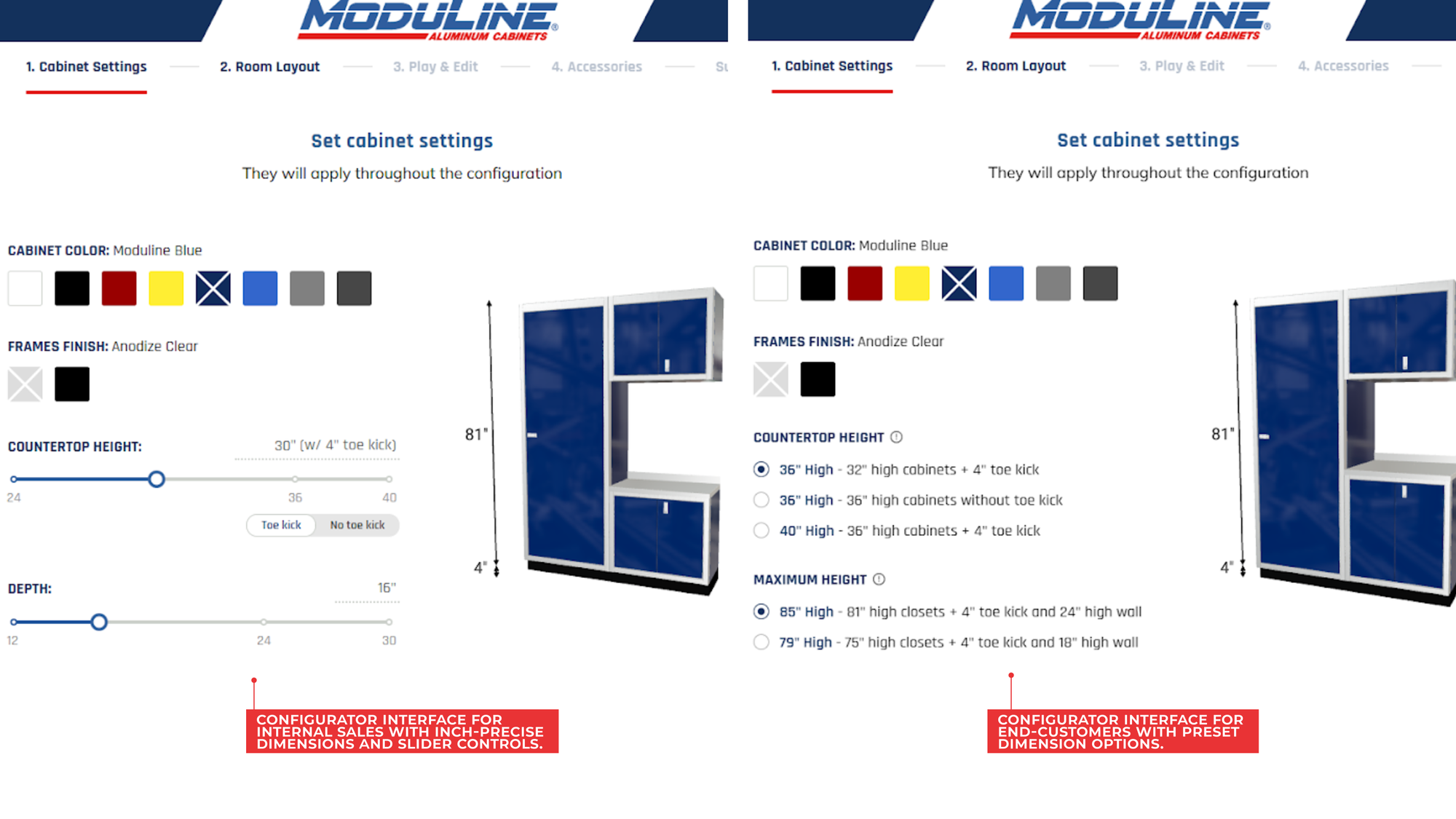One Configurator, Many Users: How User Management Keeps Features in the Right Hands
Not all users need the same 3D configurator experience. Learn how user management helps you tailor features for customers, resellers, sales teams, and admins—all in one system.

A 3D configurator brings value to different users for different reasons. End customers use it to explore and feel confident in their purchase. Sales reps use it to generate quotes quickly. Partners and resellers need control without complexity, while internal teams often need full access.
Because each group interacts with the configurator differently, it makes sense to tailor the experience to their specific needs. That’s where user management comes in. It lets you control who sees what, ensuring everyone gets the right functionalities without confusion. This post breaks down 4 key user types and how user management helps support them.
When Do You Need User Management?
If you’re building or using a 3D configurator to serve multiple user types, you need a way to manage permissions, capabilities, and access. Otherwise, you're either over-complicating the interface for end customers or limiting the tools your sales team needs to do their job.
You need user management if:
- You sell through a partner or reseller network
- Internal sales teams need access to backend systems or advanced overrides
- You want to hide pricing or certain features from some users
- You need to control who can apply discounts, generate quotes, or edit configurations
- Different user groups have different levels of product knowledge or access needs
Let’s break down what each type of user needs and how user management helps you deliver that experience.
4 User Roles and Needs in 3D Configurators
1 - The End Customer / Buyer
Who They Are: The people buying the product, often for themselves, in some cases also for direct clients. In most cases they don’t buy the product frequently, so they will not be familiar with the product or the configurator tool.
What They Need:
- Clarity – As they don’t know the product or the configurator, they need to understand what they’re getting, what’s possible with the product, and what each choice means.
- Simplicity – There’s a limit to their attention span. They don’t want to deal with complex features or go through long tutorials to buy a product.
- Wow Factor – Great quality 3D product visualization, animations, augmented reality, and any other features that help increase the perceived value of the product need to be accessible to them.
What They Typically Have Access To:
- A streamlined version of the interactive 3D product configurator, without advanced configuration features, and possibly a limited catalog
- All possible visual features (3D product viewer, AR, 360 product view, virtual photography…)
- Ability to add the configuration to cart and checkout
- Access without an account – though an account can be required in order to filter out the less serious browsers
- Often, but not always, they can see the product’s price
2 - The Reseller / Partner
Who They Are: Sales professionals for third-party companies, who sell the product to end customers. They can go by different names: resellers, partners, dealers, or designers. This role is common for higher-ticket or more complex products, which require product knowledge or a high-touch sales approach. They sell regularly and are familiar with both the product and the 3D configurator.
What They Need:
- Fulfilling the Buyer’s Needs – They want to offer the ideal product to their customer, which means they need extensive product customization options.
- Quoting Speed – They don’t want to keep their customers waiting. In many cases they use the configurator with the client to show them all the options in real time, so they need the process to be fast.
- Validation – They need to make sure that what they are showing is manufacturable and available to the buyer.
- Presentation Tools – They need to be able to show the configuration to the buyer, answer any questions, and let the buyer access relevant information (3D view, AR, …)
What They Typically Have Access To:
- More advanced configuration features than those accessible to end customers
- Specifications and technical documentation
- A lower price than end customers
- For products with more complex processes, a quoting system to track deals, approvals, and order fulfilment

3 - The Internal Sales Team
Who They Are:Your in-house salespeople. They work closely with engineering and operations, and they often need to bend or override certain rules.
What They Need: Everything resellers need, plus:
- Full Customization – They need to configure any feasible product, including edge cases.
- Rule Overrides – They understand the product well and know when exceptions apply. Sometimes they need to bypass constraints, apply discounts, or override calculated values.
- Internal Workflows – They need access to quoting approvals, inventory checks, and order tracking—like ERP or CRM.
What They Typically Have Access To:
- Everything available to end customers and partners
- The full catalog and all features of the 3D product configurator
- A configuration mode with fewer (or no) constraints—certain rules apply to 99% of cases, so the configurator applies them. But sales know what they’re doing and they want to cover that 1%
- Ability to apply discounts to specific quotes
Access to other systems like order tracking, internal approvals, and engineering outputs like BOM, CAD, engineering drawings.
4 - The Administrator
Who They Are:A small group of people in the company who manufacture or sell the product. They can make modifications to the configurator, manage access for other types of users, and access all tools with no limits.
What They Need:
- Managing the configurator parameters – From changing pricing, starting configurations, to configurator logic, available products, or other parameters.
- Managing other users – Giving or revoking access to other users, and assigning the appropriate permissions.
- Monitoring systems – Checking data from all systems, from analytics to ERP.
What They Typically Have Access To:
- Configurator Admin Panel that allows them to modify values available in the configurator live, without needing to contact the 3D configurator provider
- User Management system
- All relevant internal systems
How User Management Works With Salsita 3D Configurators
Salsita 3D Configurators come with a user management system that allows fine grained control of which users can access each feature in the configurator, or associated tools.It’s based on a flexible tag system:
- Tags are assigned to each user
- Each tag controls access to a feature or capability
- Tags can be combined however you need
Example Tags You Can Use:
- view-pricing – allows users to see product prices
- apply-discounts – enables discount fields or manual price overrides
- admin-panel-access – grants access to edit configurator properties
- override-validations – unlocks advanced features or overrides validations (for example, allows editing product dimensions to arbitrary precision, instead of using the discrete set of fixed values shown to users without this tag)
- user-management – gives access to invite, edit, or remove users
Tags are independent, so you can mix and match to suit your needs. This gives you precise control over what each user can see and do.
Users with access to the user management system are able to:
- Invite new users via email
- Assign or remove tags
- View all users
- Remove users
Wrapping Up
Different users need different things from a configurator—some just want to visualize a product, others need quoting tools, and some need full control. Instead of showing everyone the same interface, user management lets you adapt the experience based on who’s using it.
User management helps you support different types of users with a single configurator, without compromise. It’s how you give everyone what they need—and nothing they don’t.
If you want to know more about this feature and how we can implement it for you, reach out to us.

